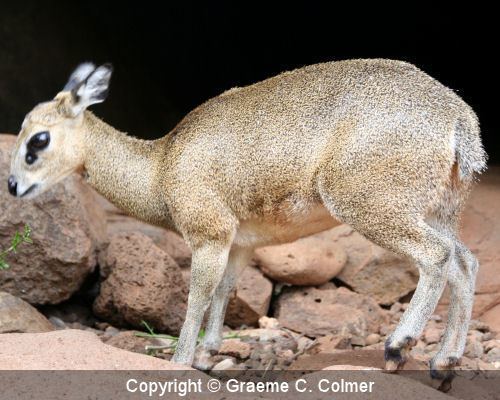Order Artiodactyla Genus Madoqua Higher classification Dik-dik | Phylum Chordata Scientific name Madoqua guentheri Rank Species | |
 | ||
Similar Dik‑dik, Salt's dik‑dik, Silver dik‑dik, White‑bellied duiker, Peters' duiker | ||
G nther s dik dik and a pair of slender mongooses
Günther's dik-dik (Madoqua guentheri) is a small antelope found in arid zones of East Africa.
Contents
- G nther s dik dik and a pair of slender mongooses
- Description
- Distribution and habitat
- Ecology
- Conservation
- References
Description
Günther's dik-dik is one of the smallest ungulates in Africa, weighing 3–5 kilograms (6.6–11.0 lb) when fully grown. It has a yellowish-gray to reddish-brown coat, black hooves, small heads with long necks and large ears with white insides. Belly, chin, breast, throat and inner thighs are cream or white. The tail is short (~3–5 cm). Males are horned, with horn length (~9.8 cm) varying between individuals. Although the horn cores are only present in males, gender identification can be difficult from a distance. Females are larger and lack horns.
Four subspecies have been proposed based on size and pelage features, but have not yet been verified by genetic analyses.
Distribution and habitat
The species is found in the lowlands of Ethiopia, most of the northern and eastern regions of Kenya, Somalia excluding specific regions of the coast, limited regions of southeastern Sudan, and Uganda. They avoid coastal regions. Typical habitat includes low thicket-type vegetation in thornbush, savanna grassland and riverine woodland biomes, and extends to disturbed and overgrazed areas. Habitat overlaps with other small antelope species such as Kirk's dik-dik.
Ecology
Günther's dik-dik is a browser rather than a grazer, taking few grasses but preferring leaves, flowers, stems, fruit and seeds. The species feeds on plants close to the ground, due to its small stature. It is primarily diurnal, with activity peaks from dawn until mid-morning and mid-afternoon until after dark. The species is monogamous; parents and calves do not form family groups for prolonged periods, and the calf is driven out at an early age to fend for itself. Only a single calf is born at a time. The species does not breed seasonally and can have late gestation periods.
While it has a limited vocal repertoire, the species has been shown to make use of the alarm calls of other species, for example responding with increased vigilance or flight behaviour to the alarm calls of the white-bellied go-away-bird.
Conservation
The species is classified as Least Concern by the IUCN, as it appears to be common throughout its range. Total population size is estimated as somewhat more than 500,000 individuals. It is known to be hunted for meat, but not commercially. Habituation to human presence may have a negative fitness effect on individuals raised in captivity, but this has not yet been verified.
